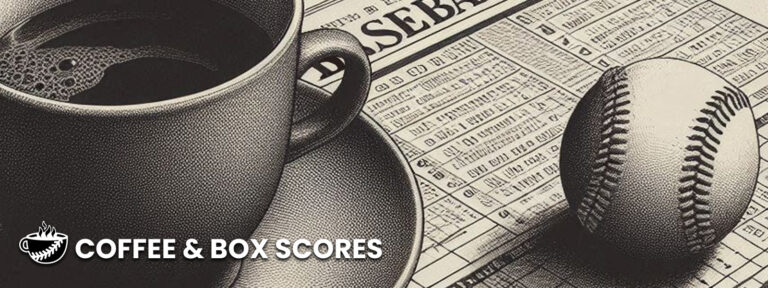It’s Hall of Fame consideration season. Until the announcement of the new class, Connections will be looking at some of the names on the 2025 ballot.
In 1911, Wildfire Schulte – a fixture in the Cubs outfield during that club’s rampage through the NL over the past six seasons – erupted for one of those campaigns that, thanks to its combination of numbers and roll-off-the-tongue juiciness, remains everlasting. The NL MVP sprayed 30 doubles, raced to 21 triples and drove a league-leading 21 home runs. It was the first 20-20-20 season ever produced by a Major League ballplayer. To add a little more symmetrical deliciousness to the platter, Schulte also contributed 23 stolen bases.
17 years later, Jim Bottomley matched Schulte’s 20-20-20 feat, and then on the 30th anniversary of the first such season, Jeff Heath made the duo a trio. Another 15 years passed, and then Willie Mays, like Schulte, hit the twenties in all four categories. In the last year of the 1970s, George Brett joined up (like Bottomley and Heath, lacking the 20 steals). As three-base hits withered and the 20-triple season fell exclusively into the realm of single-digit homerers*, the quintet appeared as if it may stay undisturbed, a remnant of a forever-gone brand of production.
*Over the 25 seasons from 1980 through 2004, triples fell from .26 per team game to .18, and there were only three players to amass at least 20 three-baggers in a season – they (Willie Wilson, Lance Johnson and Cristian Guzmán) hit four, nine and eight home runs, respectively.
And then the door to the five-man club was battered down, not by lone wolf huffing and puffing, but by a pair in 2007 – what in the world happened?
Curtis Granderson and Jimmy Rollins – a pair of names populating the 2025 Hall of Fame ballot – happened.
On Opening Day of that ’07 season, the idea of milestones thickened the air. Tom Glavine entered the campaign 10 victories shy of 300. Craig Biggio sat just 70 hits away from 3,000. Frank Thomas needed 13 bombs to join the 500 club, Jim Thome needed 28 and Álex Rodríguez required 36. Ken Griffey, Jr. – with 563 four-baggers – held an outside shot of joining the 600-club. Sammy Sosa was nearer to reaching that rare bar, with 588. Barry Bonds had closed to within 21 homers of matching Henry Aaron’s career record. A pair of punchouts would usher Pedro Martínez into the 3,000-strikeout association. John Smoltz needed 222 K’s to join that same club. A 20-win season would place Randy Johnson in the 300-win alliance. There’s something so sweeping about a watch like this, an invitation to check the box scores after every tick in the countdown to immortality, the extended anticipation of witnessing an active great closing in on links to the past via the beauty of baseball’s magical numbering structure.
Granderson and Rollins offered something altogether different, for there was no expectancy brimming over the Opening Day festivities, no conversational countdown that coincided with the start of the season. Instead, their conjoined pursuit arrived as a jolt, one that began from the season’s accumulated numbers that then instigated the historical review to realize, “Oh, this doesn’t happen often – let’s watch this unfold.” Each entered the All-Star break with double digits in triples: Granderson with 15 (the most in any first half in the All-Star era, back to 1933), Rollins at 10. The Tigers’ outfielder also claimed 24 doubles and 12 homers, while the Phillies’ shortstop owned 22 two-baggers and 16 longballs. A chase was on, a surprise addition to all the other quests hovering over the daily box scores.
Granderson would get there first, hitting his 20th homer on September 7 to join the 20-20-20 club. Rollins would draw the tension to the very end, leaving his 20th triple (he had reached 20 doubles and 20 homers long before) until the sixth inning of the final game of the season. By then, Granderson had added the fourth 20 (in steals) to join Schulte and Mays; when Rollins raced to third with that 20th triple on September 30, he made that trio a quartet (20 steals, for him, was also far in the rearview mirror). Imagine: a club that saw its origin in 1911 and claimed only one other member in the next 95 seasons had suddenly doubled in size.
It was quite the star turn for Detroit’s center fielder, an ascendant continuation of his 2006 campaign when he was one of the young faces of the Tigers’ astounding run to the AL pennant (Granderson slashed a combined .313/.378/.719 in the ALDS and ALCS that year). Aside from authoring the third 20 x 4 season ever, his 23 triples stood as the most in the Majors since 1949; he was almost perfect on the basepaths, going 26-for-27 in attempts (for the Majors’ best SB%, min. 20 attempts); looking back, his 7.6 bWAR that year was the best for an AL center fielder in a decade, since Griffey, Jr. was roaming and rolling in Seattle. At 26 years old, Granderson looked primed for stardom.
The 28-year-old Rollins was already there, the three-time All-Star ultimately named his league’s MVP that year. It’s easy to quibble at the voting that season, but Rollins’ breadth of accomplishment was still something special to behold: a league-leading 139 runs scored (to accompany his NL-best 20 triples), 212 hits, a brilliant 41 steals in 47 attempts, an almost inconceivable 88 extra-base hits, still the second most ever for a shortstop. It was the offensive peak for the Philly favorite, a single-year showcase made significantly showier by that 20 to the power of four display. He finished his career with a 47.6 bWAR, 25th among all shortstops (min. 50% of career games at short), between Jim Fregosi and Miguel Tejada/Art Fletcher.
Granderson would have a second act as an attention-getting batter, leading the AL in runs and RBI in 2011 while clubbing 41 home runs. He was the first center fielder since Griffey, Jr. (again in 1997) to lead the AL in both categories. A year later, his 43 homers made him the seventh center fielder ever to have multiple years of 40-plus bombs (joining Duke Snider, Mickey Mantle, Willie Mays, Griffey, Jr., Jim Edmonds and Andruw Jones). He’d conclude his career with a 47.2 bWAR, 34th among all center fielders (min. 50% of career games in center), between Devon White and Mike Cameron.
Different career arcs, different positions, different draws on the collective baseball consciousness: Granderson and Rollins claim virtually no connective tissue, aside from their eerily similar bWAR and membership in the 20-20-20-20 club. Seeing their names on the ballot this go-round (Rollins is making his fourth appearance, Granderson his first) is an echo from 2007. In that uncommon season where historic achievements were common*, the two supercharged the milestone motif, not only connecting to Wildfire Schulte in 1911 and Willie Mays in 1957, but to each other in a powerful, remarkable way.
*Glavine, Biggio, Thomas, Thome, Rodríguez, Sosa, Bonds and Martínez all reached their magical numbers. At the end of the year, Griffey, Jr. was seven homers shy of 600, Smoltz 25 strikeouts short of 3,000 and Johnson 16 wins away from 300.
Thanks to Baseball Reference and its extraordinary research database, Stathead, for help in assembling this piece.

Roger Schlueter
As Sr. Editorial Director for Major League Baseball Productions from 2004-2015, Roger served as a hub for hundreds of hours of films, series, documentaries and features: as researcher, fact-checker, script doctor, and developer of ideas. The years at MLB Production gave him the ideal platform to pursue what galvanized him the most – the idea that so much of what takes place on the field during the MLB regular and postseason (and is forever beautifully condensed into a box score) has connections to what has come before. Unearthing and celebrating these webs allows baseball to thrive, for the present can come alive and also reignite the past.


